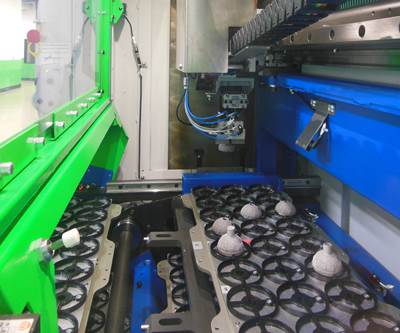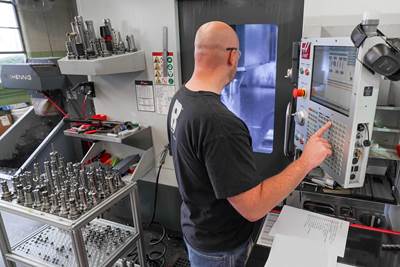Custom Workholding Shaves Days From Medical Part Setup Times
Custom workholding enabled Resolve Surgical Technologies to place all sizes of one trauma part onto a single machine — and cut days from the setup times.
Share






Takumi USA
Featured Content
View More

Hwacheon Machinery America, Inc.
Featured Content
View More
Resolve must produce implants in multiple sizes to fit people of every size. One of the largest challenges with automating this task is finding workholding that can accommodate workpieces of multiple sizes.
Every body is different, and so every medical implant must be different. Not every part that Marquette, Michigan-based medical manufacturer Resolve Surgical Technologies makes is a custom implant, but they do make up a significant portion of its high-mix, low-volume workload. These parts can have complex geometries and come in a wide range of sizes, making efficient production challenging and automation almost impossible. “Almost,” because the company has devised ways to centralize production of some implant part families on single machines. Recently, Resolve found a way to do so for a trauma part by pairing its Matsuura five-axis machines with custom workholding from Mate Precision Technologies — a combination that has reduced setup times from days to minutes and enabled up to 22 hours of continuous uptime.
Custom Production
Resolve is no stranger to custom work — though usually from the other side of the client-manufacturer relationship. The shop operates as a Contract Design Manufacturing Organization PLUS (CDMO+) facility, a workflow model which Continuous Improvement Manager Dan Sloat describes as a combination of design and production. In essence, medical parts manufacturers will approach Resolve with a task and collaboratively design the part and its manufacturing process with the shop, then Resolve will have the first contract for the job. From there, Resolve maintains the product line, managing part design files and regulatory documentation.
Resolve’s success requires a well-optimized fleet of machines. To meet its tasks, Resolve uses over 50 Tsugami Swiss machines, three Willemin-Macodel B-axis head five-axis turn-mills and three Matsuura five-axis mills in addition to several wire EDMs, 3+2 mills, four-axis horizontals, another turn-mill and a smaller B-axis head five-axis VMC. The company largely works with metals — primarily a mix of titanium, 316L stainless steel, 17-4 stainless steel for its instruments and implants, with some aluminum, exotic metals and plastics for odd jobs.
The shop’s parts tend to top out at a foot in length, with its smallest parts going down to 0.030 inch in length. While some of these parts have regular orders — medical screws, for example — many instruments come in small batches, and the implants tend to involve even more custom work that requires complex parts to be produced in multiple sizes. Resolve is able to automate production of higher-volume parts and small batches of similarly sized parts through regular use of bar feeders on its Swiss machines and pallets on its mills. These strategies face difficulties with the custom implants, however, as the shop would need a common workholding solution for multiple complex parts of different geometries.

An additional challenge to automating Resolve’s trauma part was the need to fit nine pallets and parts of various sizes inside its Matsuura MX330’s work envelope. This tight enclosure is 300 mm high and 330 mm wide.
One Platform, Five Axes
This was a key issue for one of its trauma implants, which can be of vastly different sizes depending on the severity of the recipient’s injury and require extremely difficult angles. When Resolve first began making these parts, it needed to swap back and forth between milling and EDM work, requiring five setups for each part.
With about 80 parts per batch, and batches running nearly continuously through the facility, automation would be a massive boon for this part. Several years ago, the company began using five-axis machines to cut down on setups, but its Matsuura machines could only handle the larger versions of this part in their stock state.
Sloat knew that the shop would need to adopt custom workholding to fit the whole part family on its pallets, and Mate was fresh in his mind after a demonstration from tooling representative Tom Lemkau and a webinar from Modern Machine Shop. When Sloat and a few other members of Resolve visited Matsuura’s Minneapolis location in December 2022 to view potential solutions, they made sure to stop by Mate’s local facility — and quickly found themselves impressed. By January 2023, Sloat had designed a potential workholding solution in SolidWorks and was in conversation with Mate about potentially producing it.
This wasn’t a situation where Mate merely took an order and produced the workholding, however. Instead, after the companies had agreed on an initial design, Mate’s production engineering team and Resolve’s team scheduled weekly calls to review the design and determine if Mate’s prototyping and finite element analysis uncovered any ways to streamline the design or improve its functionality. Tim Reevs, senior operations engineer at Resolve, says that these calls led to the team revising its design from aluminum to steel, as well as the integration of an adapter at the base of the tombstone to improve rigidity. After initial attempts to pair a Mate base plate with an in-house custom fixture resulted in repeatability issues, Mate was also able to step in and develop a custom fixture which eliminated the issues with holding the base plate.
The final workholding product, delivered in stages between April and July 2023, consists of 20 custom tombstones which each fit eight DynoLock bases. Its custom, low-profile dovetails are just large enough that pushers can grab onto the dovetail while ensuring the part and base fit in the Matsuura MX-330’s work envelope. Threads on the top and the bottom of the Mate DynoGrip vises enable Resolve to use bolt stops to improve repeatability, and color-coded bolts help distinguish between batches of parts. The adapter plates can fit every size of the implant, and Reevs says they could potentially enable the shop to tackle other oddly shaped parts with the Matsuuras, not just this implant.
The addition of Mate’s workholding solution lets Resolve set up the Matsuura machines for 22 hours of continuous operation and require only around 10 minutes for setup. By comparison, previous production methods took hours of dialing in parts for each setup.

The design of Resolve’s cervical plates best suits them to mill-turn machines. Experiments in tool vending machines and MachineMetrics recently started here, with the team learning how best to deploy these technologies before expanding them to the full shop floor.
Tooling and Monitoring
Though the machining process with Mate is perhaps the most mature automation process for custom implants at Resolve, it is not the only one. The shop also maintains a cell that produces components for a cervical plate. Sloat says the Willemin-Macodel turn-mills of this cell, like the Matsuuras, can run multiple sizes of the part on the same machine. The only difference here is that the vise currently needs changing between different part sizes.
Resolve has taken steps to ensure around-the-clock operations for these machines. The shop’s tooling provider, PF Markey, has installed tool vending machines for the area. Each tool is identified by a photo on the vending machines’ screen to ensure machinists get what they need faster. PF Markey intends to install this system around the Resolve manufacturing floor, and at the time of my visit in April 2024, had already installed and optimized this system in the cervical plate area.
Additionally, Resolve had only just launched MachineMetrics on its shop floor a few months before my visit, and the cervical plate area was also the first to benefit from the machine monitoring platform. Sloat says that his team was still familiarizing itself with the software, but had already grown accustomed to checking uptime and downtime to see if any machinists needed assistance, as well as using work counters. These counters track the number of parts run through the machines and enable Resolve to investigate the optimal intervals between part inspections.
The One-Stop Dream
Resolve intends to create its parts in as few setups as possible, in as compact a space as possible. This holds true to its feelings about secondary operations, too, with Resolve performing laser-etching, anodizing, heat treatment, fatigue testing and radiation testing in-house. The facility can provide sterile packaging as well, so that parts proceed complete from bar to their client without needing to rely on external shops.
Fitting all of these processes into one facility has required some judicious investment decisions to be sure each machine — and each bit of tooling — can pull its weight. Sloat counts the Mate workholding project as a success in this regard, both in terms of the equipment and the company’s service offerings. The next time Resolve is in the market for custom milling workholding, he says, Mate will be high on his list.
Related Content
Building Machines and Apprenticeships In-House: 5-Axis Live
Universal machines were the main draw of Grob’s 5-Axis Live — though the company’s apprenticeship and support proved equally impressive.
Read More6 Machine Shop Essentials to Stay Competitive
If you want to streamline production and be competitive in the industry, you will need far more than a standard three-axis CNC mill or two-axis CNC lathe and a few measuring tools.
Read MoreHow to Successfully Adopt Five-Axis Machining
While there are many changes to adopt when moving to five-axis, they all compliment the overall goal of better parts through less operations.
Read MoreInverting Turning and Five-Axis Milling at Famar
Automation is only the tip of the iceberg for Famar, which also provides multitasking options for its vertical lathes and horizontal five-axis machine tools.
Read MoreRead Next
Flexible Fixturing Supports Automation
Robotics and carousel systems with custom fixtures help Akron-based Slice Mfg. Studios process hundreds of medical devices unattended.
Read MoreMedical Shop Performs Lights-Out Production in Five-Axes
Moving to five-axis machining enabled this shop to dramatically reduce setup time and increase lights-out capacity, but success relied on the right combination of workholding and automation.
Read MoreMate Precision Machinable Hard Jaws Hold Complex Part Geometry
IMTS 2024: Mate Precision Technologies highlights its machinable hard jaws, which are customizable and designed to handle complex geometries, as well as its 52/96 workholding system.
Read More













































